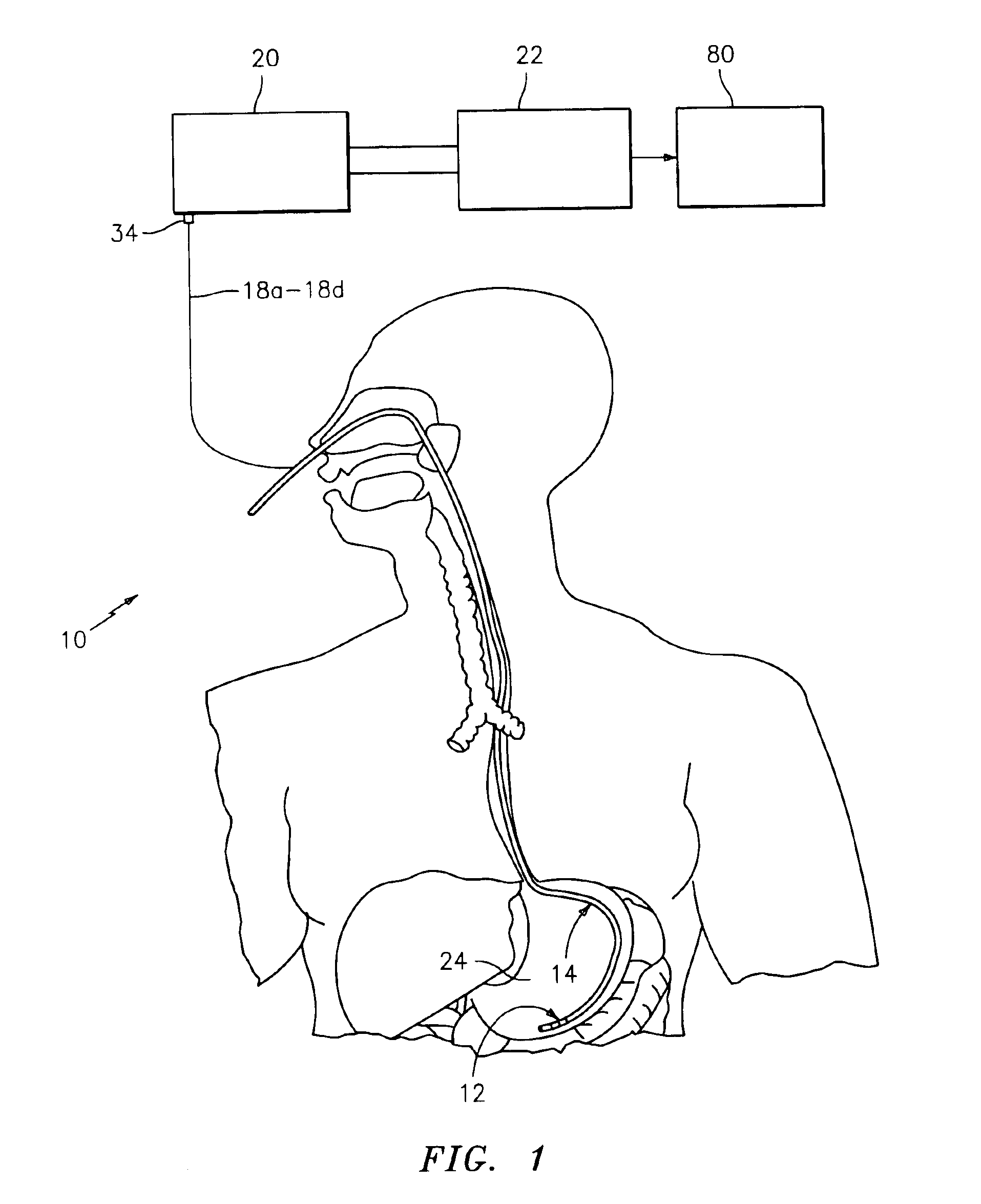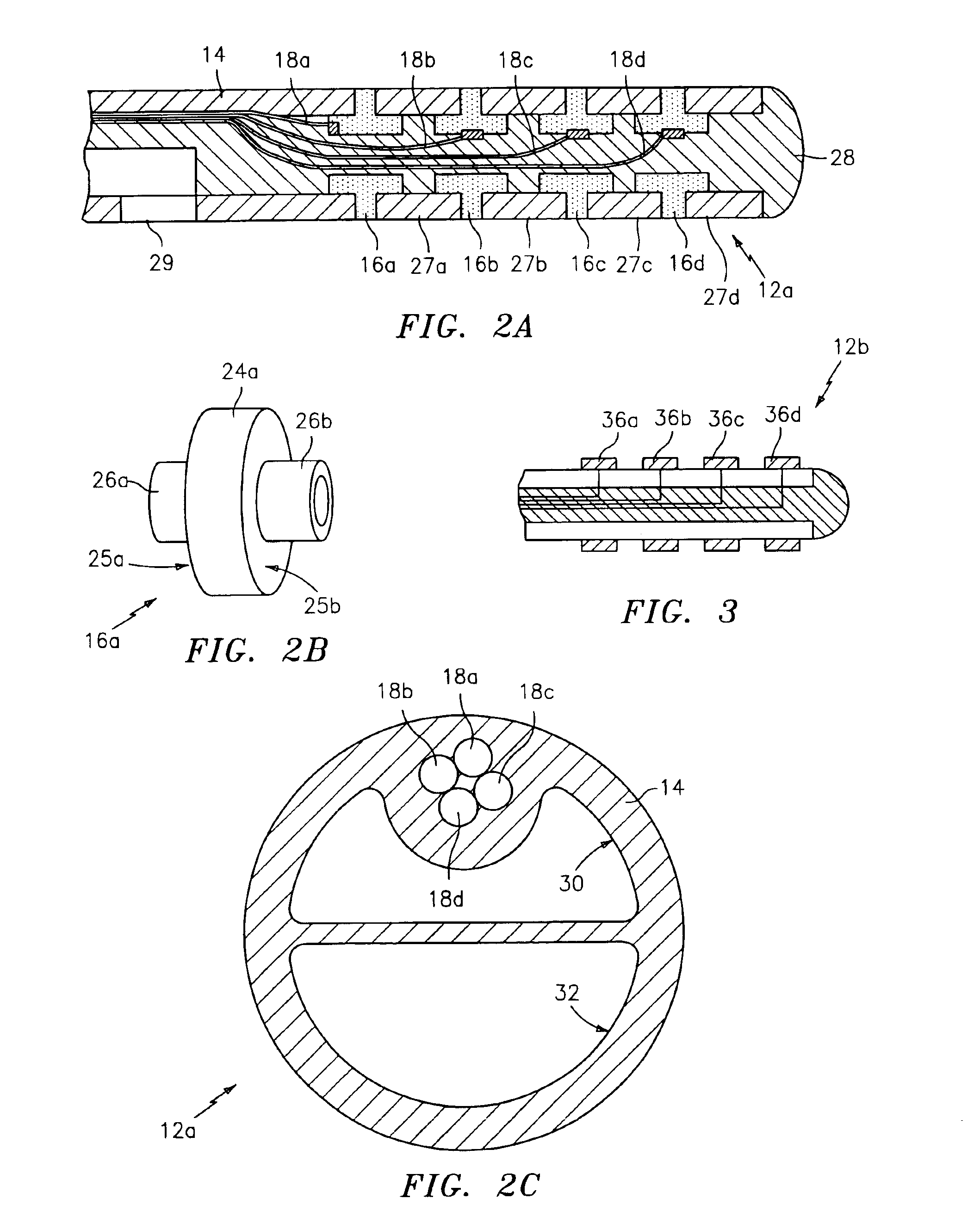Impedance spectroscopy system and catheter for ischemic mucosal damage monitoring in hollow viscous organs
a hollow viscous organ and ischemic mucosal damage technology, which is applied in the field of impedance spectroscopy system and catheter for monitoring ischemic mucosal damage in hollow viscous organs, can solve the problems of no clinically acceptable method for directly monitoring ischemic mucosal damage, no clinically acceptable method for impedance spectroscopy measurements of inner walls, and no clinically acceptable method for ischemic mucosal damag
- Summary
- Abstract
- Description
- Claims
- Application Information
AI Technical Summary
Benefits of technology
Problems solved by technology
Method used
Image
Examples
third embodiment
[0034]FIGS. 4A-4C show the catheter 12c. The catheter 12c is generally similar to the catheter 12a, but has spacers (e.g., 42a, 42b, 42c), provided with annular internal sockets or spacer lips (e.g., 52a, 52b), into which flanged electrodes (e.g., 44a, 44b) lock into place. In this sample interlocking means, each flanged electrode (e.g., 44a, 44b) has a cylindrical central portion (e.g., 46a, 46b) having a first diameter and two annular side surfaces, two extensions (e.g., 48a, 48b) attached to the ends of the central portion and coaxial therewith, and an axial through-bore. The extensions (e.g., 48a, 48b) each have a second, reduced diameter, but instead of being purely cylindrical, the extensions (e.g., 48a, 48b) have annular electrode lips (e.g., 50a, 51a) that face towards the central portion 46. Additionally, the spacers (e.g., 42a-42c) are made of flexible plastic tubing (i.e., a relative non-conductor of electricity) or the like. Each spacer has two annular, inwardly-facing s...
fourth embodiment
[0037]FIGS. 5A-5C show the catheter 12d. The catheter 12d comprises: an injection-molded, plastic tip 60; two or four electrodes 62a-62d; one or three spacers 64a-64c (i.e., in the case of two electrodes, one spacer is needed, while three spacers are needed for a four electrode catheter); dual-lumen tubing 66 or the like; and the cables or leads 18a-18d. As best shown in FIG. 5B, the plastic tip 60 comprises a rounded fore portion 68 and a rounded, trough-like projection 70 that extends back from the fore portion 68. As indicated, the tip 60 can be injection molded, or it can be made via another suitable manufacturing process. The electrodes 62a-62d and spacers 64a-64c are generally similar in shape. Each has a small, cylindrical passageway (e.g., 72a, 72b, 72c, 72d) for the cables 18a-18d, as well as a rounded through-bore (e.g., 74a, 74b, 74c, 74d) through which the trough-like projection 70 of the tip 60 is dimensioned to fit (i.e., the rounded through-bores, e.g., 74a, 74b, 74c,...
PUM
| Property | Measurement | Unit |
|---|---|---|
| length | aaaaa | aaaaa |
| diameter | aaaaa | aaaaa |
| outer diameter | aaaaa | aaaaa |
Abstract
Description
Claims
Application Information
 Login to View More
Login to View More - R&D
- Intellectual Property
- Life Sciences
- Materials
- Tech Scout
- Unparalleled Data Quality
- Higher Quality Content
- 60% Fewer Hallucinations
Browse by: Latest US Patents, China's latest patents, Technical Efficacy Thesaurus, Application Domain, Technology Topic, Popular Technical Reports.
© 2025 PatSnap. All rights reserved.Legal|Privacy policy|Modern Slavery Act Transparency Statement|Sitemap|About US| Contact US: help@patsnap.com



